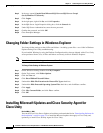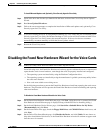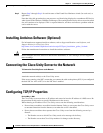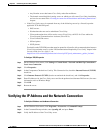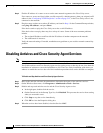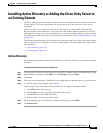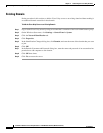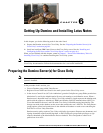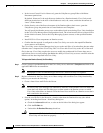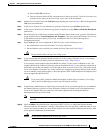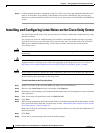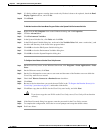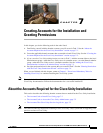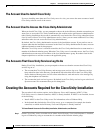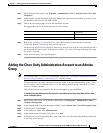
6-2
Installation Guide for Cisco Unity Release 5.x with IBM Lotus Domino (Without Failover)
OL-13599-01
Chapter 6 Setting Up Domino and Installing Lotus Notes
Preparing the Domino Server(s) for Cisco Unity
• In the Access Control List for Names.nsf, grant the UnityServers group Editor with Delete
Documents permissions.
By default, Names.nsf is the main directory database for a Domino domain. Cisco Unity needs
sufficient permissions in the ACL of the database to read, edit, create, and delete documents (or
“notes”) in the database.
• On the Security tab of the Server document of the Domino address book server, grant the
UnityServers group the permission to Create Databases and Templates.
You will specify the Domino server to use as the address book server during Cisco Unity installation
in the Cisco
Unity Message Store Configuration wizard. The wizard must be able to create mail files
for the default accounts, such as the Unity Messaging System account, on the specified Domino
server.
• Install DUC for Cisco components on Domino servers.
• Confirm that the network is configured so that Cisco Unity can resolve the unqualified Domino
server name to an IP address.
The Cisco Unity server also has Manager-level access to the mail files of its subscribers because when
a Domino user is imported into Cisco
Unity, DUC for Cisco adds Cisco Unity to the ACL of the mail
file for the user. Cisco
Unity requires the access to modify the read/unread list. Ensure there are no
explicit deny lists or security settings that hinder the ability of Cisco
Unity to access a mail file after the
Domino user has been imported into Cisco
Unity.
To Prepare the Domino Server(s) for Cisco Unity
Step 1 Create a group of type MultiPurpose for the Cisco Unity server, and name it UnityServers. Refer to the
applicable IBM Lotus documentation.
Note Multipurpose is the recommended type, but Access Control List Only is acceptable.
Step 2 Register a Person for the Cisco Unity server. Most settings will not affect Cisco Unity functionality,
however, you must do the following:
• Create a Lotus Notes mail file for the Person.
Note All Cisco Unity voice messages are submitted to mail.box on the Domino server on which you
create the Lotus Notes mail file. Messages are then routed to the Domino servers on which
Cisco
Unity subscribers are homed. Create the Lotus Notes mail file on a Domino server that is
well connected to the network.
• Save the user ID file for the Person in a location other than the Domino directory (the default
option). In the Register Person—New Entry dialog box:
a. Check the Advanced check box, so tabs on the left side of the dialog box appear.
b. Click the ID Info tab.
c. Uncheck the In Domino Directory check box.
Caution If you save the ID file in the Domino directory, regardless of whether you also save it in a file,
Cisco Unity will not function properly.



